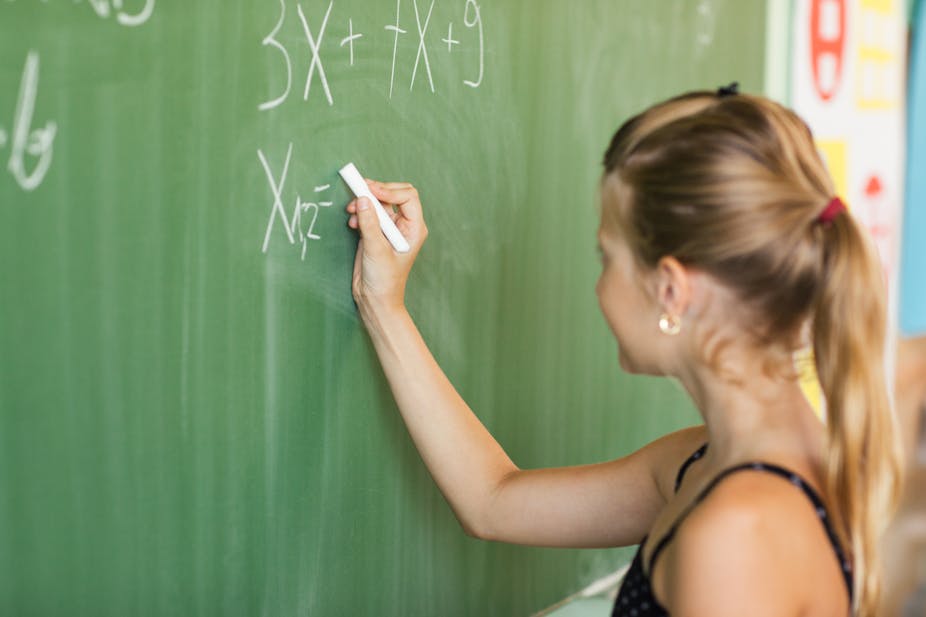There has been a lot of hand-wringing about mathematics lately. According to national and international testing we are not getting any better at it and plenty of good reasons have been offered for why this may be so. Not enough students are studying it, not enough students like it, and not enough qualified teachers teach it. But a much less discussed explanation is that some of our kids fail in maths because they can’t read the questions.
How is maths teaching changing?
Students often complain they can’t see the point of maths - beyond basic arithmetic. In response, keen teachers look for ways to show them how maths is relevant to their daily lives. Trigonometry is set inside problem solving about rugby ball angles and penalty kicks, probability is used to predict the winners of X Factor and Pythagoras’ theorem is applied to save people from a burning building.
This shift to meaning and context in learning maths is laudable, but it does fundamentally change the nature of maths teaching in ways that teachers are not currently trained for.
When we build stories around maths problems to give them a real-life relevance, we introduce contexts that may be unfamiliar to some students, or information that is irrelevant to the maths of the question. One of the questions in the most recent PISA maths tests began:
Ninety-five percent of world trade is moved by sea, by roughly 50,000 tankers, bulk carriers and container ships. Most of these ships use diesel fuel. Engineers are planning to develop wind power support for ships. Their proposal is to attach kite sails to ships and use the wind’s power to help reduce diesel consumption and the fuel’s impact on the environment.
None of this information was necessary to solve the mathematical question that followed. A student may spend a deal of time distracted by this information, either trying to read it successfully or trying to figure out if the paragraph contains anything crucial to the maths question that followed.
Being a good reader with a broad general knowledge has become integral to mathematical achievement, so teaching language has become a necessary part of teaching maths.
Many maths teachers roll their eyes when talk turns to teaching language in the maths classroom. They already have a packed schedule just trying to fit the maths content in, let alone teach language - and, anyway, isn’t that the English teacher’s job?
But being an avid reader of novels is no guarantee of success in maths, as the mathematics classroom generates its own unique mix of everyday language and maths-specific language. It is only the maths teacher who has the discipline knowledge to teach it. This is equally true for the generalist primary teacher who must also teach how language works differently in every subject area, including maths.
Language in the maths classroom
Vocabulary is the key to success in reading comprehension and this is particularly true in mathematical reading. In a novel, unknown words can often be guessed from context, or even skipped, and meaning can still be maintained. However, in maths, if one word is not understood it is probable the entire sentence will be misconstrued.
In the PISA example given earlier there is no redundancy in the maths question that followed the lengthy prelude information.
At what approximate speed does the wind blow into a kite sail when a wind speed of 24 km/h is measured on the deck of the ship?
The linguistics of this question are more complex than the maths it seeks to test.

Often, words in mathematics can seem familiar to the student but are used in ways that are specific to maths. For example, in this question from a Year 7 maths textbook the word “decimated” is key to getting the maths right.
99 Roman soldiers who fled from battle were to be punished. The group was lined up and decimated. How many were killed?
Mathematically, “decimated” maintains its original meaning of “one in ten”. In common parlance, however, “decimated” has come to mean “completely wiped out”. Clearly, the two interpretations of the word “decimated” will each result in a very different answer to this maths problem, but only one will be correct in the maths classroom.
It’s not just words. Sentences can also work differently in mathematics. Usually in English there is a sequential logic to sentences; we start at the beginning and read through to the end and rely on this predictability for comprehension.
However, in mathematics the logic of sentences may be organised in more unexpected ways. For example, “Draw a circle with a diameter of one-third the sum of 6+9+15”, requires the learner to start the operation from the end of the sentence and move backwards through to the beginning of the sentence in order to successfully complete the instruction.
These language differences need to be explicitly taught to students, but very often the language is so familiar to teachers they fail to notice what they should be making visible to their students.
All teachers need a strong and explicit understanding of how the English language works. Knowing your content simply isn’t enough to make a real difference to student learning outcomes.
Why it matters
Students who fail in mathematics are less likely to go on to further study and more likely to have lower-paying jobs.
To teach maths properly we have to be clear on whether students are getting it wrong because they don’t understand the maths or because they can’t comprehend the questions. Either is serious, and both require very different teaching solutions. Teachers must take up the challenge and teach both the content and the language of mathematics, but how well prepared are they to do that?

